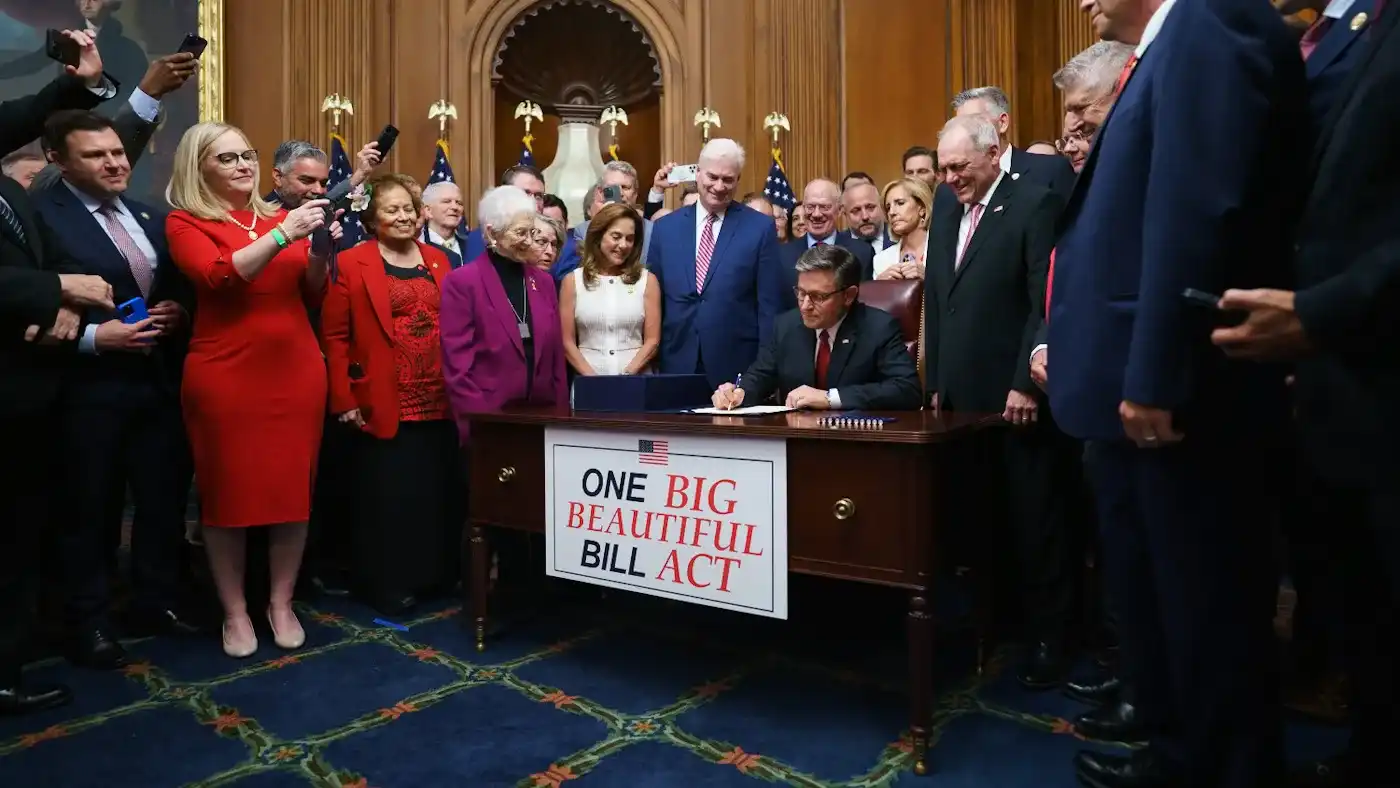In the early hours of July 4, 2025, the "One Big Beautiful Bill Act" (OBBBA) finally passed in the House of Representatives with a narrow margin of 218-214 votes after more than 24 hours of a "voting marathon," with crypto-supporting Vice President JD Vance casting the crucial support vote.
Read more: "What’s in the 'One Big Beautiful Bill' that Infuriated Musk"

This core bill, seen as a "universal" measure for Trump's second term, has sparked intense debate within the Republican Party and between the two parties. Its comprehensive fiscal policies are bound to impact the macroeconomic trends in the U.S. and globally. Although OBBBA does not directly involve the crypto market, its implications for U.S. Treasury bonds, taxation, remittance taxes, and regulatory policies may have far-reaching effects on Bitcoin, crypto enterprises, and the U.S. dollar stablecoin market in the future.
Raising the U.S. Debt Ceiling: Safe-Haven Funds May Flow into Bitcoin
OBBBA raises the U.S. debt ceiling to $50 trillion, authorizing the government to issue more Treasury bonds to support fiscal spending. However, this large-scale borrowing may shake market confidence in the long-term stability of the U.S. dollar and Treasury bonds.
In recent years, foreign investment in U.S. Treasury bonds has been on the decline, with major holders like China and Japan continuously reducing their U.S. bond assets, reflecting a subtle shift in global investor confidence. If debt expansion triggers inflation or a crisis of confidence in the dollar, funds may accelerate their exit from the Treasury bond market in search of new safe-haven assets. In this context, Bitcoin, as a potential U.S. strategic reserve and global store of value, may become more attractive.
Historically, Bitcoin prices tend to perform strongly during periods of macroeconomic uncertainty, such as during the pandemic in 2020 and the rebound during the 2022 interest rate hike cycle. The macroeconomic uncertainty brought about by OBBBA's increase in the debt ceiling may attract institutional and retail investors to increase their holdings in Bitcoin, thereby driving up its price.
"Double Standard" Tax Policies: Mixed Blessings for Crypto Enterprises
"Protective" Tax Cuts: A Spring for U.S. Crypto Enterprises
In terms of taxation, OBBBA continues the core provisions of the 2017 Tax Cuts and Jobs Act, permanently locking individual income tax rates between 10% and 37%, while increasing the standard deduction by an additional $1,000 until 2028, and gradually raising the child tax credit to $2,500 by 2028. Although primarily aimed at individuals, these tax policies also indirectly benefit businesses, especially small and medium-sized enterprises, by increasing disposable income and investment potential for business owners.
For most crypto companies, which are primarily small and medium-sized enterprises, this means more funds can be invested in innovation. Blockchain development companies can accelerate the development of decentralized finance (DeFi) or Web3 projects, and crypto exchanges can intensify their market expansion efforts. Startups can also seize the opportunity to attract venture capital and accelerate product launches.

OBBBA also raises the state and local tax (SALT) cap from $10,000 to $40,000, increasing by 1% each year from 2025 to 2029, and reverting to $10,000 after 2030, with a gradual reduction mechanism set for high-income taxpayers at 30%. This policy will benefit residents and businesses in high-tax states, such as New York and California, which are also home to many crypto enterprises (like Coinbase and mining company Riot Blockchain) and crypto enthusiasts. The reduced tax burden will free up more capital for business owners and investors, indirectly boosting the research and development or investment in crypto projects.
"Retaliatory Taxes": A Rocky Road for International Crypto Enterprises Entering the U.S.
However, OBBBA sets heavy obstacles for non-U.S. crypto enterprises. Section 899 of OBBBA allows the U.S. Treasury to impose additional tax measures on entities from countries that implement discriminatory taxes, especially concerning digital services taxes. This aims to respond to international tax policies targeting U.S. technology and digital companies.
This policy raises the entry threshold for foreign crypto companies into the U.S. and significantly increases the operational costs for international crypto companies in the U.S. market, which may dampen the investment interest of foreign crypto enterprises in the U.S. market and pose challenges for U.S. small and medium-sized crypto enterprises that rely on international funding. A decrease in foreign capital inflow may also weaken the demand for compliant U.S. dollar stablecoins, exacerbating market volatility.
Investment Depreciation Benefits: Opportunities and Challenges for Mining Companies
OBBBA allows companies to take 100% immediate depreciation on qualified capital assets (such as equipment, software, and certain real estate) under Section 70307, explicitly extending this benefit until the 2030 fiscal year. This provision will allow crypto mining companies to fully deduct the cost of mining equipment in the year of purchase. This not only reduces the operational costs for mining companies but also enhances miners' profitability. It also facilitates mining companies to upgrade hardware or expand mining scale using additional income from founders and shareholders, alleviating some operational pressure during high electricity costs.
However, OBBBA's reduction of clean energy tax credits from the Inflation Reduction Act may put pressure on mining companies. This move will weaken support for green energy investments. Given that crypto mining companies heavily rely on electricity, the reduction in clean energy tax credits may increase renewable energy costs, adding to the operational burden of mining companies. Rising clean energy costs may force mining companies to turn to fossil fuels, triggering environmental controversies and increasing compliance costs.
Remittance Tax and the GENIUS Act: Accelerating Growth in the U.S. Dollar Stablecoin Market
Remittance Tax and the GENIUS Act: New Growth Opportunities for U.S. Dollar Stablecoins
OBBBA introduces a 1% remittance tax, significantly raising the cost of traditional cross-border remittances, directly impacting immigrants, merchants, and international trade that rely on remittances. Traditional bank transfer fees typically range from 2% to 5%, and with the additional 1% tax burden, the cost becomes excessive, prompting users to seek lower-cost alternatives.
Section 70604 explicitly states that digital asset transfers will be exempt from the remittance tax, highlighting the advantages of low-cost, low-fee, and efficient U.S. dollar stablecoins in cross-border payments. This is especially promising in regions with a high number of immigrants and a strong reliance on remittances, such as Latin America, Asia, and Africa, where OBBBA's measure is expected to further drive the growth of the U.S. dollar stablecoin market.
At the same time, the previously proposed GENIUS Act requires stablecoin issuers to back their issuance 1:1 with U.S. dollars or short-term Treasury bonds. Analysts estimate that this will release $1.2 to $1.6 trillion in new demand for U.S. Treasury bonds, and OBBBA's increase of the debt ceiling by $5 trillion precisely meets this growth demand, creating a synergistic effect with the U.S. dollar stablecoin policy and injecting strong momentum into the U.S. dollar stablecoin market.
Regulation and Dollar Hegemony: The Global Era of U.S. Dollar Stablecoins
OBBBA further strengthens the regulation of stablecoins and the international dominance of the U.S. dollar. Section 606 encourages the Treasury to collaborate with international regulatory bodies to establish unified regulatory standards, ensuring the stability and compliance of cross-border financial instruments. This will enhance the legitimacy and market trust of U.S. dollar stablecoins, especially in the global payment and remittance sectors, attracting more institutional investors.
However, strict anti-money laundering and reserve requirements may increase compliance costs, potentially overwhelming small and medium-sized stablecoin issuers and driving them out of the market, further concentrating the market landscape of U.S. dollar stablecoins towards giants like Tether and Circle.
Section 608 explicitly reinforces the U.S. dollar's dominant position in international payments and reserves by limiting the substitution effect of other currencies, fully supporting the widespread use of the dollar in cross-border transactions. This strategy not only solidifies U.S. financial hegemony but also indirectly promotes the circulation of U.S. dollar stablecoins in the global market, preventing challenges to its status from other currencies and stablecoins.
Conclusion
While OBBBA may seem unrelated to the crypto market, its tax and regulatory policies create a friendly environment for the growth of U.S. crypto enterprises and U.S. dollar stablecoins. The increase in military spending and the strengthening of the dollar's dominant position lay a solid foundation for the global expansion of U.S. dollar stablecoins. This bill, which Trump is willing to push through even at the cost of a fallout with Musk, may soon synergize with multiple crypto and stablecoin bills, reinforcing demand for U.S. Treasury bonds and the status of the dollar.
免责声明:本文章仅代表作者个人观点,不代表本平台的立场和观点。本文章仅供信息分享,不构成对任何人的任何投资建议。用户与作者之间的任何争议,与本平台无关。如网页中刊载的文章或图片涉及侵权,请提供相关的权利证明和身份证明发送邮件到support@aicoin.com,本平台相关工作人员将会进行核查。




